QAC020C152A - Java OOP Project: Design of Bright College Management
VerifiedAdded on 2023/05/30
|20
|3723
|151
Project
AI Summary
This project presents a Java-based solution for a Bright College Management System, employing object-oriented programming principles. The system comprises three main classes: Course, Student, and Bright. The Course and Student classes model respective entities with encapsulated data members and accessor/mutator methods. The Bright class serves as the main application entry point, managing ArrayLists of Student and Course objects. Key functionalities include adding students, processing fees, listing students by course, changing courses, viewing student profiles, and generating management reports. The design leverages encapsulation and method overriding to promote code reusability and data integrity. The included Java code provides a practical implementation of the system's features, demonstrating core OOP concepts.

1 Design and Development
To develop the Bright College Management system, Java programming language is used. Java is an
object-Oriented language and is the most appropriate language to use to develop the proposed system.
By using different Object Oriented design patterns, the proposed application will be able to take
advantage of most important object oriented design patterns like encapsulation and method overriding.
To demonstrate the design of the proposed system, a domain class diagram can be used to show the
classes and objects that will make up the system.
To develop the Bright College Management system, Java programming language is used. Java is an
object-Oriented language and is the most appropriate language to use to develop the proposed system.
By using different Object Oriented design patterns, the proposed application will be able to take
advantage of most important object oriented design patterns like encapsulation and method overriding.
To demonstrate the design of the proposed system, a domain class diagram can be used to show the
classes and objects that will make up the system.
Paraphrase This Document
Need a fresh take? Get an instant paraphrase of this document with our AI Paraphraser
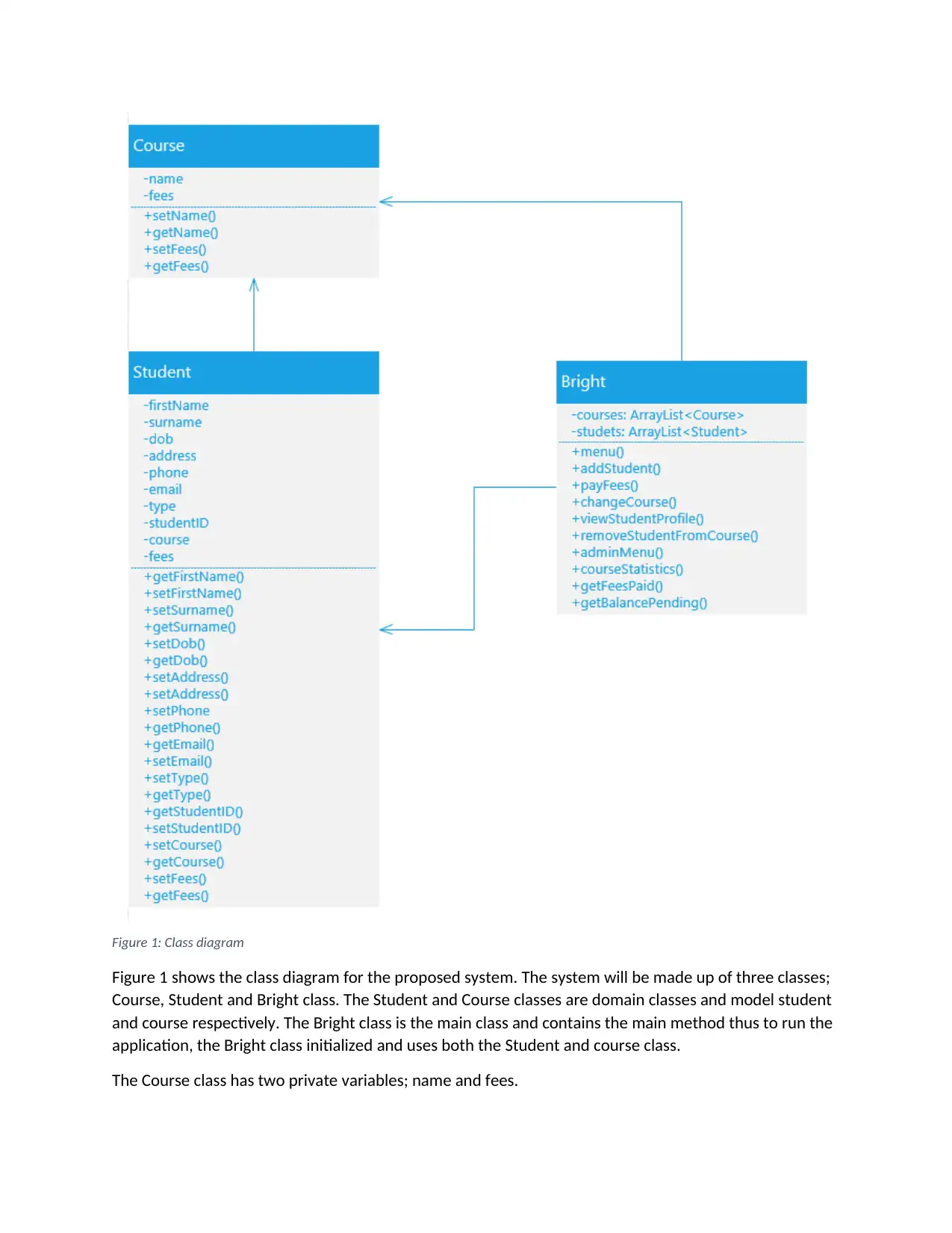
Figure 1: Class diagram
Figure 1 shows the class diagram for the proposed system. The system will be made up of three classes;
Course, Student and Bright class. The Student and Course classes are domain classes and model student
and course respectively. The Bright class is the main class and contains the main method thus to run the
application, the Bright class initialized and uses both the Student and course class.
The Course class has two private variables; name and fees.
Figure 1 shows the class diagram for the proposed system. The system will be made up of three classes;
Course, Student and Bright class. The Student and Course classes are domain classes and model student
and course respectively. The Bright class is the main class and contains the main method thus to run the
application, the Bright class initialized and uses both the Student and course class.
The Course class has two private variables; name and fees.

Both of the variables are declared as private variables. Variables are then instantiated using the public
constructor which takes parameters of both variables and then instantiates them in the body. For each
variable there is a getter method which can also be referred to as accessor. This method is a public
method which can be accessed by another class. The accessor is used to access the value of the variable
held by the private variable. There is also another method called setter which is also referred to as a
mutator. The mutator is used to set or change the value of the private variable and is declared as a
public method to make it accessible outside the class.
The student class also has variables which are declared as private variables. The private variables
defining the student class are; first name, surname, dob, address, phone, email, type, studentID and
course.
This variables are passed as parameters in the public constructor of the student class. Each of the
variable has a mutator and accessor method.
The process of using getter and setter methods for the two classes is done to achieve encapsulation.
Encapsulation is the process of wrapping data and code together into a single using. A fully encapsulated
class has data members all of which are declared as private and then setter and getter methods are used
to set and get the data. Using encapsulation in java has a few advantages including;
Using getters and setters for a class makes the class write –only and read-only. For read only
classes only getter method are implemented while for write-only classes only setter methods
are implemented. This provides more control over the data.
Encapsulation helps achieve data hiding because by declaring private data members, other
classes cannot access the data members unless getter methods are implemented.
Encapsulation makes it easy to test the code especially for unit testing.
Apart from the getter and setter methods implemented in both classes, there are other methods that
define each of the classes. Both classes have an overridden toString method which returns the data of
the class as a string formatted in a specific format. Method overriding enables the subclasses to
implement a different implementation of the overridden method from the implementation of the
superclass. The overridden toString method enable the string to be returned in a specific format. The
constructor which takes parameters of both variables and then instantiates them in the body. For each
variable there is a getter method which can also be referred to as accessor. This method is a public
method which can be accessed by another class. The accessor is used to access the value of the variable
held by the private variable. There is also another method called setter which is also referred to as a
mutator. The mutator is used to set or change the value of the private variable and is declared as a
public method to make it accessible outside the class.
The student class also has variables which are declared as private variables. The private variables
defining the student class are; first name, surname, dob, address, phone, email, type, studentID and
course.
This variables are passed as parameters in the public constructor of the student class. Each of the
variable has a mutator and accessor method.
The process of using getter and setter methods for the two classes is done to achieve encapsulation.
Encapsulation is the process of wrapping data and code together into a single using. A fully encapsulated
class has data members all of which are declared as private and then setter and getter methods are used
to set and get the data. Using encapsulation in java has a few advantages including;
Using getters and setters for a class makes the class write –only and read-only. For read only
classes only getter method are implemented while for write-only classes only setter methods
are implemented. This provides more control over the data.
Encapsulation helps achieve data hiding because by declaring private data members, other
classes cannot access the data members unless getter methods are implemented.
Encapsulation makes it easy to test the code especially for unit testing.
Apart from the getter and setter methods implemented in both classes, there are other methods that
define each of the classes. Both classes have an overridden toString method which returns the data of
the class as a string formatted in a specific format. Method overriding enables the subclasses to
implement a different implementation of the overridden method from the implementation of the
superclass. The overridden toString method enable the string to be returned in a specific format. The
⊘ This is a preview!⊘
Do you want full access?
Subscribe today to unlock all pages.

Trusted by 1+ million students worldwide
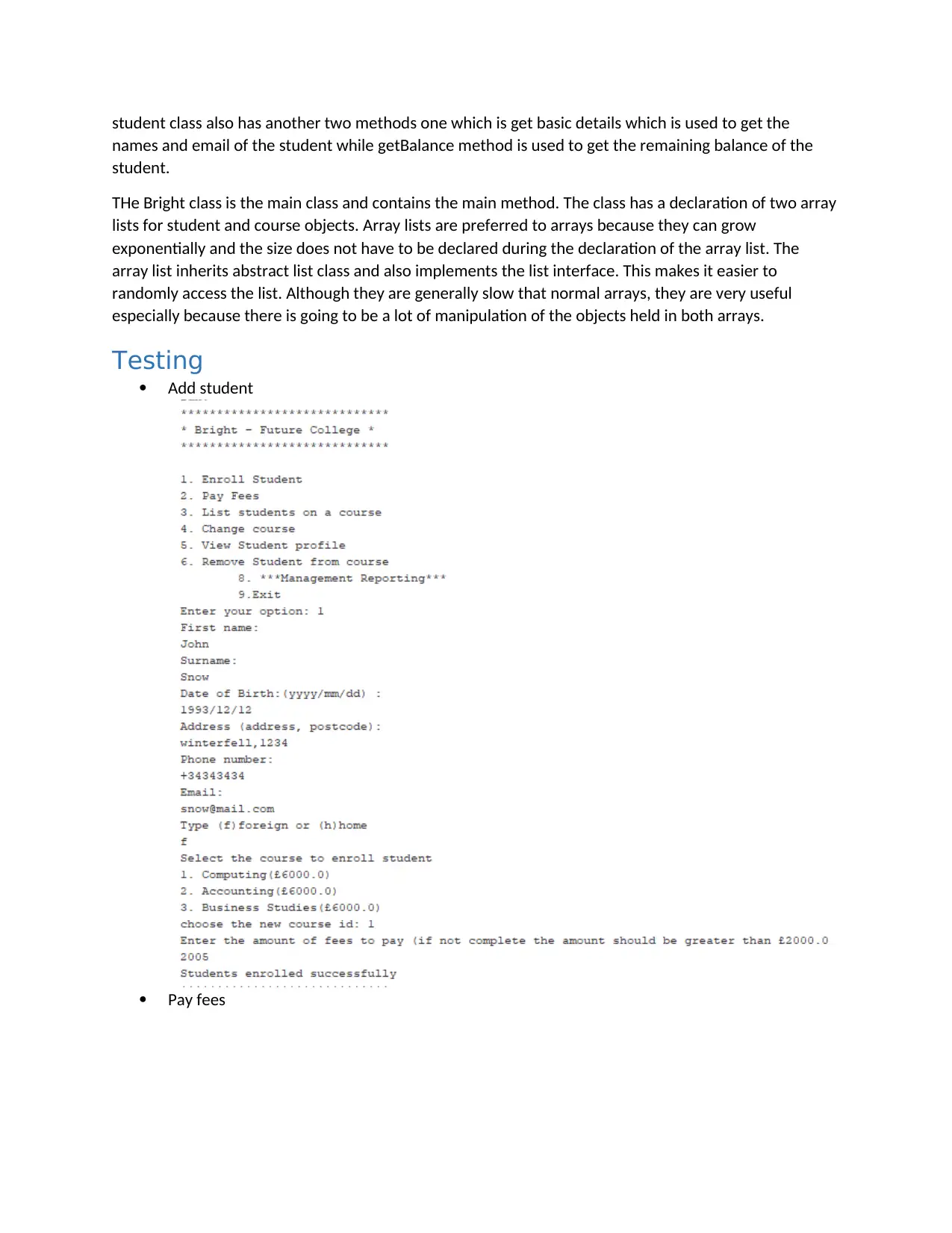
student class also has another two methods one which is get basic details which is used to get the
names and email of the student while getBalance method is used to get the remaining balance of the
student.
THe Bright class is the main class and contains the main method. The class has a declaration of two array
lists for student and course objects. Array lists are preferred to arrays because they can grow
exponentially and the size does not have to be declared during the declaration of the array list. The
array list inherits abstract list class and also implements the list interface. This makes it easier to
randomly access the list. Although they are generally slow that normal arrays, they are very useful
especially because there is going to be a lot of manipulation of the objects held in both arrays.
Testing
Add student
Pay fees
names and email of the student while getBalance method is used to get the remaining balance of the
student.
THe Bright class is the main class and contains the main method. The class has a declaration of two array
lists for student and course objects. Array lists are preferred to arrays because they can grow
exponentially and the size does not have to be declared during the declaration of the array list. The
array list inherits abstract list class and also implements the list interface. This makes it easier to
randomly access the list. Although they are generally slow that normal arrays, they are very useful
especially because there is going to be a lot of manipulation of the objects held in both arrays.
Testing
Add student
Pay fees
Paraphrase This Document
Need a fresh take? Get an instant paraphrase of this document with our AI Paraphraser

List students on a course
Change course
Change course
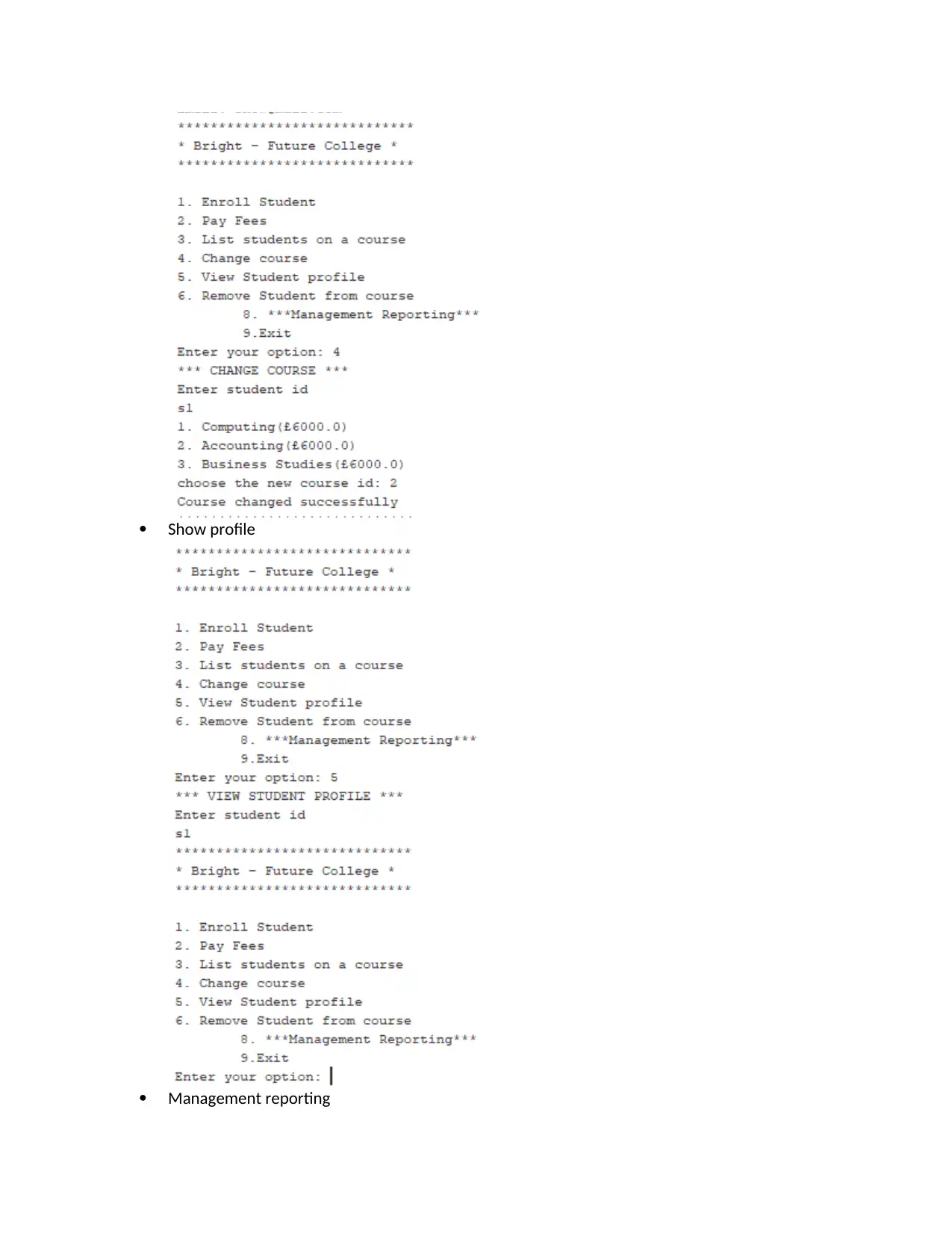
Show profile
Management reporting
Management reporting
⊘ This is a preview!⊘
Do you want full access?
Subscribe today to unlock all pages.

Trusted by 1+ million students worldwide
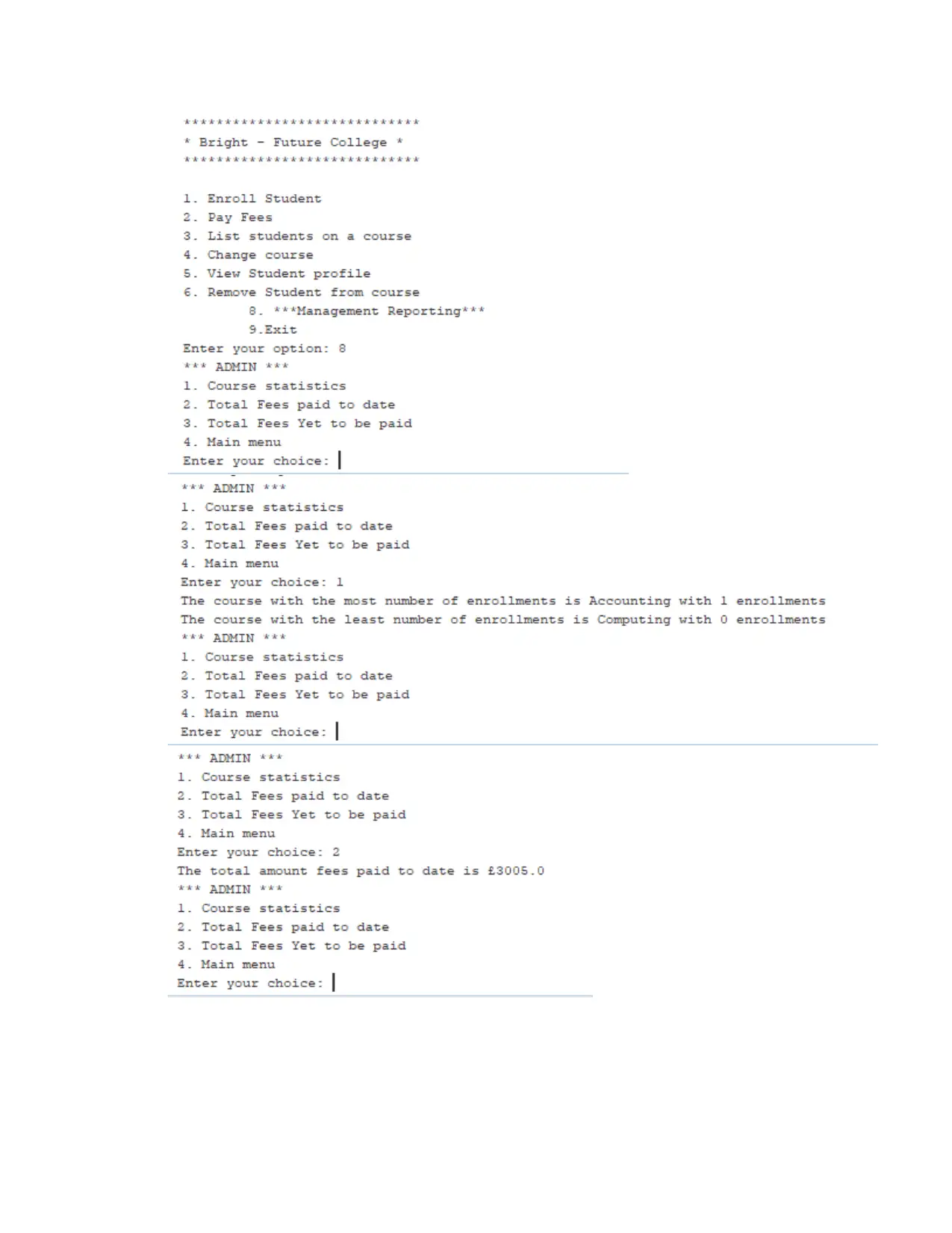
Paraphrase This Document
Need a fresh take? Get an instant paraphrase of this document with our AI Paraphraser
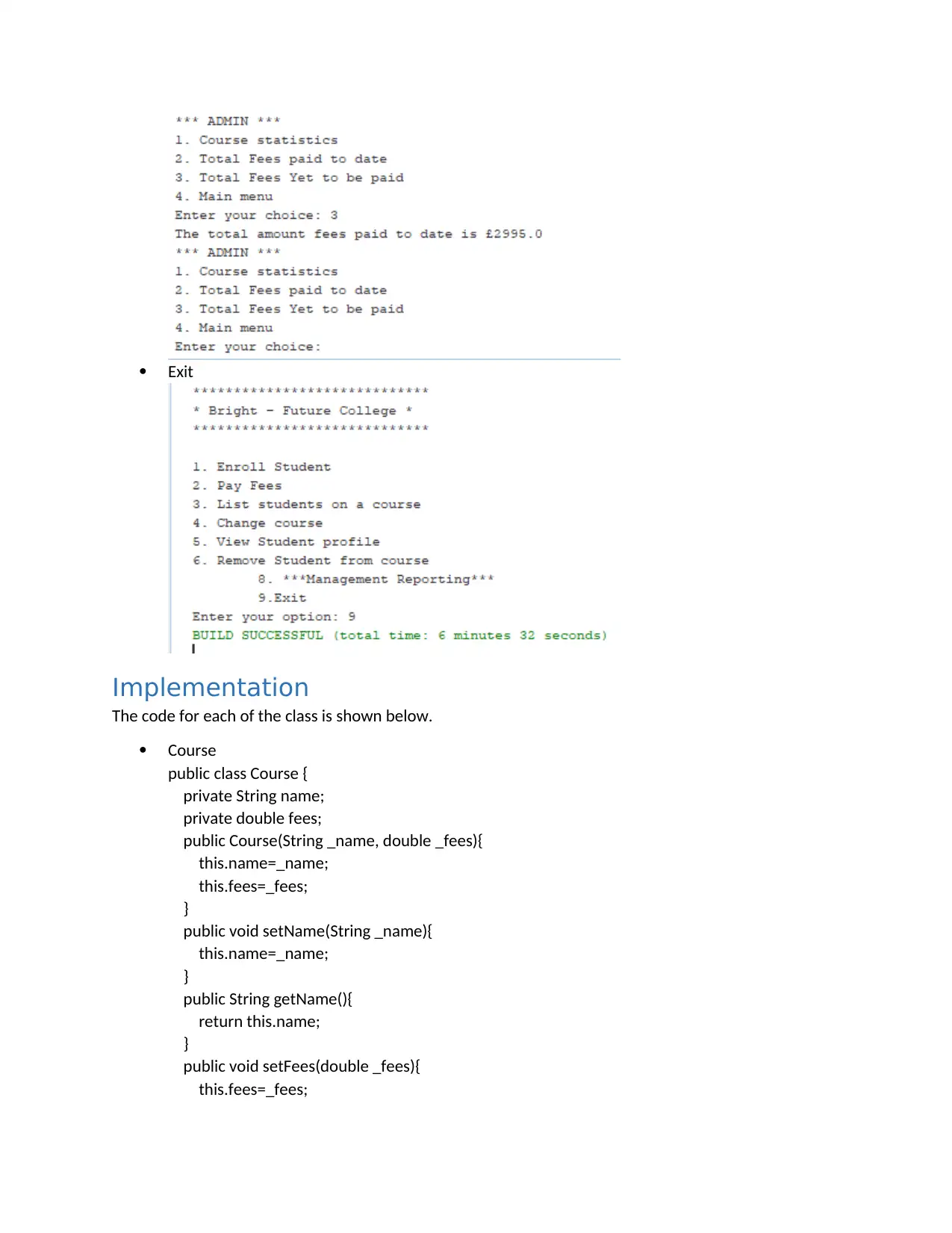
Exit
Implementation
The code for each of the class is shown below.
Course
public class Course {
private String name;
private double fees;
public Course(String _name, double _fees){
this.name=_name;
this.fees=_fees;
}
public void setName(String _name){
this.name=_name;
}
public String getName(){
return this.name;
}
public void setFees(double _fees){
this.fees=_fees;
Implementation
The code for each of the class is shown below.
Course
public class Course {
private String name;
private double fees;
public Course(String _name, double _fees){
this.name=_name;
this.fees=_fees;
}
public void setName(String _name){
this.name=_name;
}
public String getName(){
return this.name;
}
public void setFees(double _fees){
this.fees=_fees;

}
public double getFees(){
return this.fees;
}
@Override
public String toString(){
return this.name+"(£"+this.fees+")";
}
}
Student
public class Student {
private String firstName, surname, dob, address, phone, email,type,studentID;
private Course course;
private double fees;
public Student(String _fname, String _surname, String _dob,String _address, String _email,
String _type, String _id,Course _course, double _fees,String _phone){
this.firstName=_fname;
this.surname=_surname;
this.dob=_dob;
this.address=_address;
this.email=_email;
this.type=_type;
this.studentID=_id;
this.course=_course;
this.fees=_fees;
this.phone=_phone;
}
public void setFirstName(String _fname){
this.firstName=_fname;
}
public String getFirstName(){
return this.firstName;
}
public void setSurname(String _surname){
this.surname=_surname;
}
public String getSurname(){
return this.surname;
}
public void setDob(String _dob){
this.dob=_dob;
}
public String getDob(){
public double getFees(){
return this.fees;
}
@Override
public String toString(){
return this.name+"(£"+this.fees+")";
}
}
Student
public class Student {
private String firstName, surname, dob, address, phone, email,type,studentID;
private Course course;
private double fees;
public Student(String _fname, String _surname, String _dob,String _address, String _email,
String _type, String _id,Course _course, double _fees,String _phone){
this.firstName=_fname;
this.surname=_surname;
this.dob=_dob;
this.address=_address;
this.email=_email;
this.type=_type;
this.studentID=_id;
this.course=_course;
this.fees=_fees;
this.phone=_phone;
}
public void setFirstName(String _fname){
this.firstName=_fname;
}
public String getFirstName(){
return this.firstName;
}
public void setSurname(String _surname){
this.surname=_surname;
}
public String getSurname(){
return this.surname;
}
public void setDob(String _dob){
this.dob=_dob;
}
public String getDob(){
⊘ This is a preview!⊘
Do you want full access?
Subscribe today to unlock all pages.

Trusted by 1+ million students worldwide

return this.dob;
}
public void setAddress(String _address){
this.address=_address;
}
public String getAddress(){
return this.address;
}
public void setPhone(String _phone){
this.phone=_phone;
}
public String getPhone(){
return this.phone;
}
public void setEmail(String _email){
this.email=_email;
}
public String getEmail(){
return this.email;
}
public void setType(String _type){
this.type=_type;
}
public String getType(){
return this.type;
}
public void setStudentID(String _id){
this.studentID=_id;
}
public String getStudentID(){
return this.studentID;
}
public void setCourse(Course _course){
this.course=_course;
}
public Course getCourse(){
return this.course;
}
public void setFees(double _fees){
this.fees=this.fees+_fees;
}
public double getFees(){
return this.fees;
}
}
public void setAddress(String _address){
this.address=_address;
}
public String getAddress(){
return this.address;
}
public void setPhone(String _phone){
this.phone=_phone;
}
public String getPhone(){
return this.phone;
}
public void setEmail(String _email){
this.email=_email;
}
public String getEmail(){
return this.email;
}
public void setType(String _type){
this.type=_type;
}
public String getType(){
return this.type;
}
public void setStudentID(String _id){
this.studentID=_id;
}
public String getStudentID(){
return this.studentID;
}
public void setCourse(Course _course){
this.course=_course;
}
public Course getCourse(){
return this.course;
}
public void setFees(double _fees){
this.fees=this.fees+_fees;
}
public double getFees(){
return this.fees;
}
Paraphrase This Document
Need a fresh take? Get an instant paraphrase of this document with our AI Paraphraser
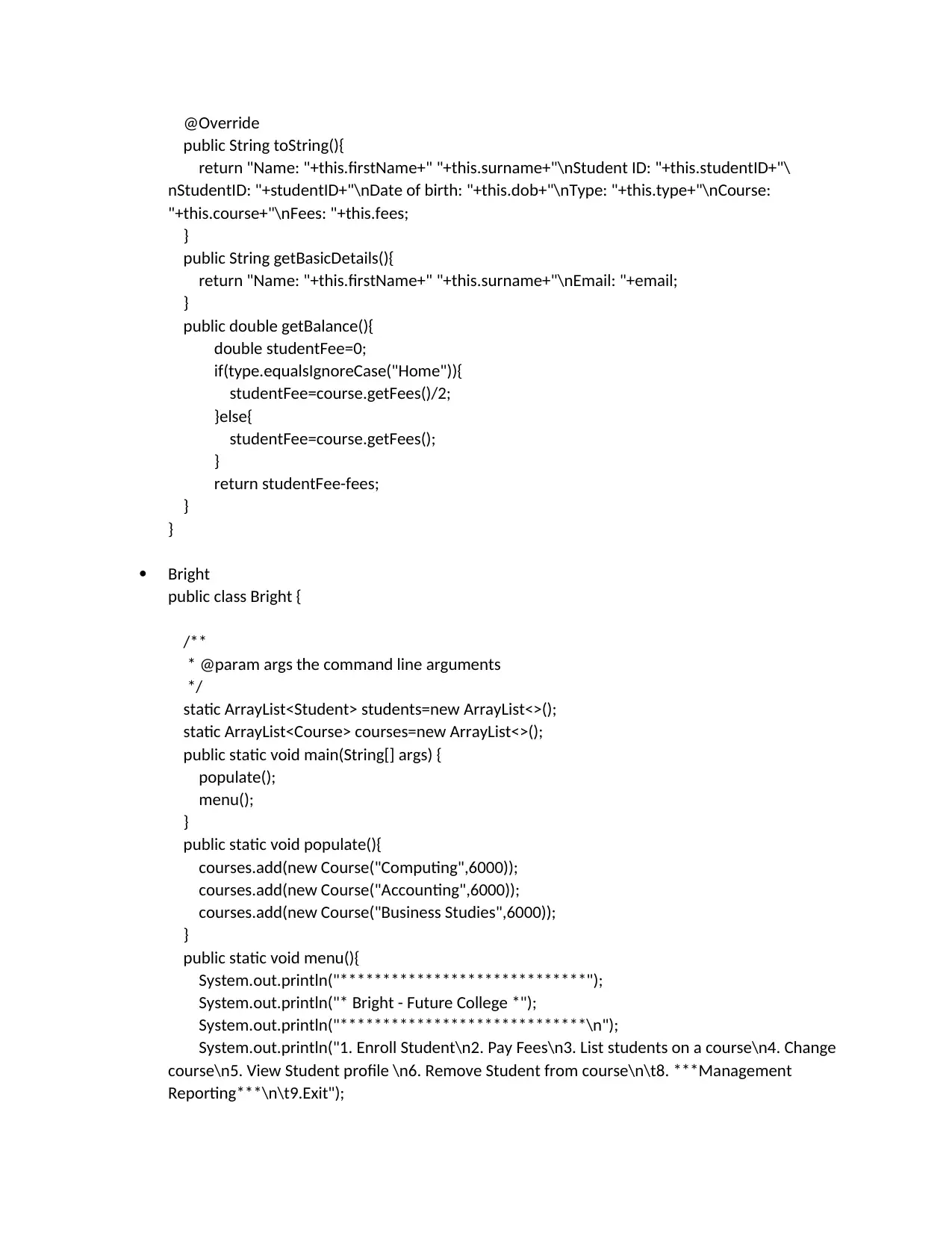
@Override
public String toString(){
return "Name: "+this.firstName+" "+this.surname+"\nStudent ID: "+this.studentID+"\
nStudentID: "+studentID+"\nDate of birth: "+this.dob+"\nType: "+this.type+"\nCourse:
"+this.course+"\nFees: "+this.fees;
}
public String getBasicDetails(){
return "Name: "+this.firstName+" "+this.surname+"\nEmail: "+email;
}
public double getBalance(){
double studentFee=0;
if(type.equalsIgnoreCase("Home")){
studentFee=course.getFees()/2;
}else{
studentFee=course.getFees();
}
return studentFee-fees;
}
}
Bright
public class Bright {
/**
* @param args the command line arguments
*/
static ArrayList<Student> students=new ArrayList<>();
static ArrayList<Course> courses=new ArrayList<>();
public static void main(String[] args) {
populate();
menu();
}
public static void populate(){
courses.add(new Course("Computing",6000));
courses.add(new Course("Accounting",6000));
courses.add(new Course("Business Studies",6000));
}
public static void menu(){
System.out.println("*****************************");
System.out.println("* Bright - Future College *");
System.out.println("*****************************\n");
System.out.println("1. Enroll Student\n2. Pay Fees\n3. List students on a course\n4. Change
course\n5. View Student profile \n6. Remove Student from course\n\t8. ***Management
Reporting***\n\t9.Exit");
public String toString(){
return "Name: "+this.firstName+" "+this.surname+"\nStudent ID: "+this.studentID+"\
nStudentID: "+studentID+"\nDate of birth: "+this.dob+"\nType: "+this.type+"\nCourse:
"+this.course+"\nFees: "+this.fees;
}
public String getBasicDetails(){
return "Name: "+this.firstName+" "+this.surname+"\nEmail: "+email;
}
public double getBalance(){
double studentFee=0;
if(type.equalsIgnoreCase("Home")){
studentFee=course.getFees()/2;
}else{
studentFee=course.getFees();
}
return studentFee-fees;
}
}
Bright
public class Bright {
/**
* @param args the command line arguments
*/
static ArrayList<Student> students=new ArrayList<>();
static ArrayList<Course> courses=new ArrayList<>();
public static void main(String[] args) {
populate();
menu();
}
public static void populate(){
courses.add(new Course("Computing",6000));
courses.add(new Course("Accounting",6000));
courses.add(new Course("Business Studies",6000));
}
public static void menu(){
System.out.println("*****************************");
System.out.println("* Bright - Future College *");
System.out.println("*****************************\n");
System.out.println("1. Enroll Student\n2. Pay Fees\n3. List students on a course\n4. Change
course\n5. View Student profile \n6. Remove Student from course\n\t8. ***Management
Reporting***\n\t9.Exit");
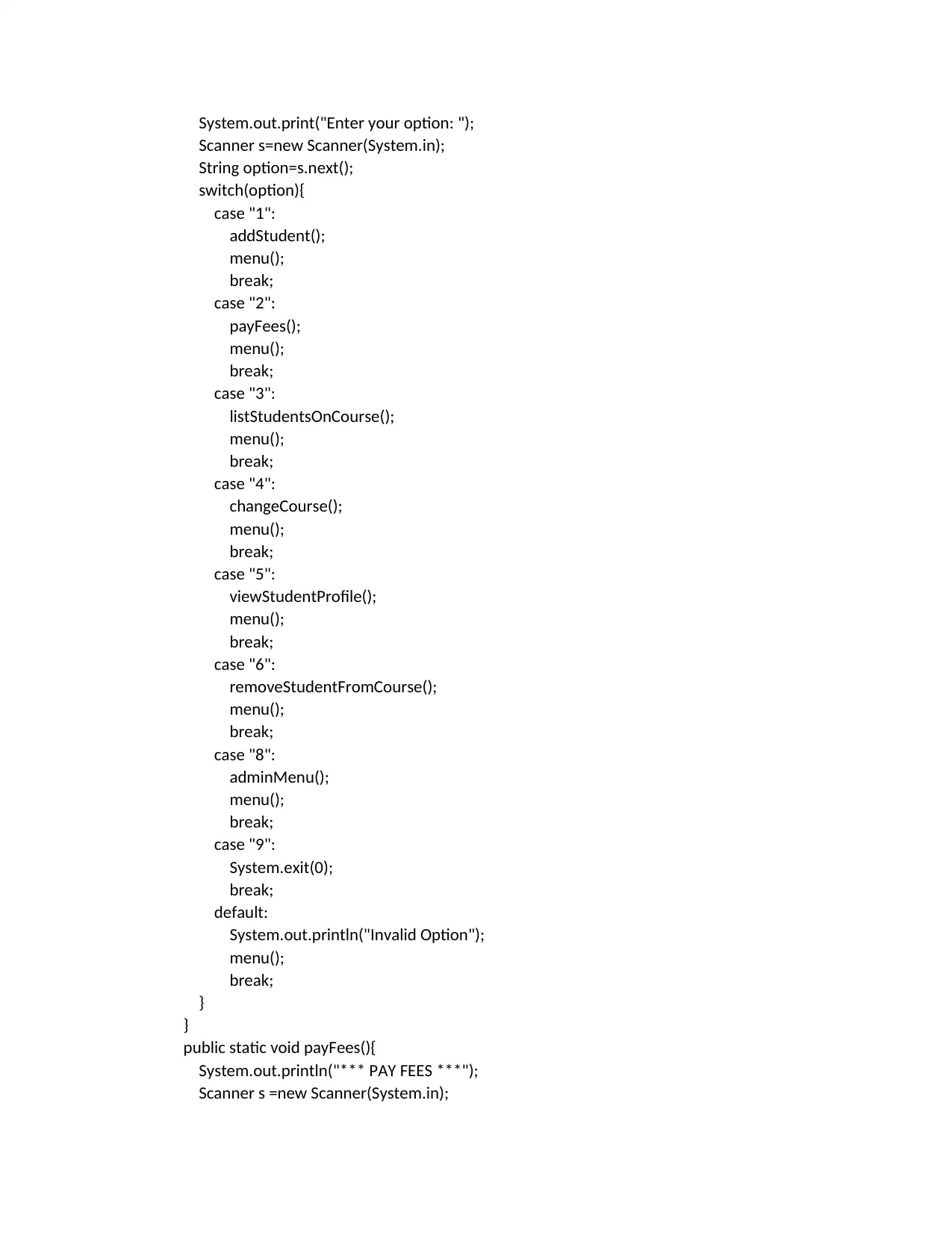
System.out.print("Enter your option: ");
Scanner s=new Scanner(System.in);
String option=s.next();
switch(option){
case "1":
addStudent();
menu();
break;
case "2":
payFees();
menu();
break;
case "3":
listStudentsOnCourse();
menu();
break;
case "4":
changeCourse();
menu();
break;
case "5":
viewStudentProfile();
menu();
break;
case "6":
removeStudentFromCourse();
menu();
break;
case "8":
adminMenu();
menu();
break;
case "9":
System.exit(0);
break;
default:
System.out.println("Invalid Option");
menu();
break;
}
}
public static void payFees(){
System.out.println("*** PAY FEES ***");
Scanner s =new Scanner(System.in);
Scanner s=new Scanner(System.in);
String option=s.next();
switch(option){
case "1":
addStudent();
menu();
break;
case "2":
payFees();
menu();
break;
case "3":
listStudentsOnCourse();
menu();
break;
case "4":
changeCourse();
menu();
break;
case "5":
viewStudentProfile();
menu();
break;
case "6":
removeStudentFromCourse();
menu();
break;
case "8":
adminMenu();
menu();
break;
case "9":
System.exit(0);
break;
default:
System.out.println("Invalid Option");
menu();
break;
}
}
public static void payFees(){
System.out.println("*** PAY FEES ***");
Scanner s =new Scanner(System.in);
⊘ This is a preview!⊘
Do you want full access?
Subscribe today to unlock all pages.

Trusted by 1+ million students worldwide
1 out of 20
Related Documents
Your All-in-One AI-Powered Toolkit for Academic Success.
+13062052269
info@desklib.com
Available 24*7 on WhatsApp / Email
![[object Object]](/_next/static/media/star-bottom.7253800d.svg)
Unlock your academic potential
Copyright © 2020–2025 A2Z Services. All Rights Reserved. Developed and managed by ZUCOL.





